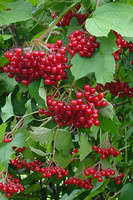Mon-Fri 9am - 5pm Mountain time
Wentworth Highbush Cranberry vs Grouseberry
Vaccinium scoparium
Viburnum trilobum Wentworth
CUSTOM GROW
NOT AVAILABLE THIS SEASON - MIGHT RETURN
Grouseberry is a native, low-growing deciduous shrub known for its edible red berries. In early summer, it produces small, urn-shaped flowers ranging from white to pink that attract bees and other pollinators. The berries provide an important food source for many types of wildlife, including game birds such as grouse, which gives the plant its common name. People can also enjoy the berries fresh or in baked goods, though they can be difficult to harvest in large quantities.
Spreading by rhizomes, Grouseberry forms dense, broom-like mats that help stabilize soil and prevent erosion, while also providing cover for ground-nesting wildlife. It is commonly found beneath conifers in open forests, subalpine meadows, and occasionally on rocky slopes in mountainous regions. It is well-suited for naturalization, ecological restoration, and soil stabilization projects.
Wentworth Highbush Cranberry is an ample producer that will make you think of the perfect cranberry sauce when you see it. Its huge fruit is delectable in jellies and sauces. In the spring it bears clusters of white flowers, contrasted against green vegetation that turns a rich red in the fall. Magnificent in garden borders or mass planting, you’ll appreciate your cranberry on your table and in your yard.

